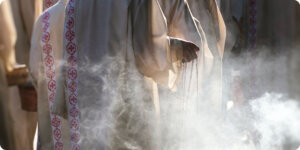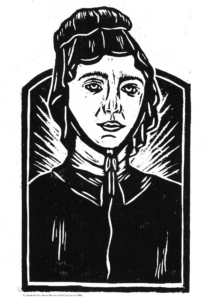The American Eucharistic Witnesses series is published in the Heart of the Revival newsletter and republished by Relevant Radio. It highlights the holy men and women who lived, loved, and served on the very soil upon which we now stand. They all testify—in unique and powerful ways—to what it means to encounter Jesus in the Eucharist and go on mission with him for the life of the world. Old and young, men and women, representing different cultural families and vocations, these men and women show us—in living color—what holiness looks like. We are also thrilled to partner with American artist Connor Miller, who is creating an original woodcut print of each witness to help us visually engage with this creative new series.
Contributed by Tom Hoopes
St. Elizabeth Ann Seton is the perfect saint to lead Catholics in the United States to rediscover the Real Presence of Jesus during our Eucharistic Revival: she is one of the most quintessentially American saints, and the Eucharist was at the center of her life.
Along with Kateri Tekakwitha, Elizabeth Ann Seton is the saint we most identify with the United States
When girls dress up for All Saints Day, the two most popular costumes could double for a play about the first Thanksgiving dinner: the Native American St. Kateri or the bonneted early settler, St. Elizabeth.
She was born in 1774 in New York where, 200 years later, Cardinal Francis Spellman summed her up this way: “When our great Republic was born, she became a charter American citizen.” He listed Alexander Hamilton and John Jay among her family’s friends and acquaintances.
Born Elizabeth Bayley, she married William Seton in an Episcopalian church and gave birth to five children. In 1803 Elizabeth accompanied her husband to Italy, seeking relief for his tuberculosis. William died later that year. It was during their time in Italy that Elizabeth discovered the Catholic faith through the witness of her husband’s business partners, the Filicchis.
Soon after she returned to the United States, the quintessential American citizen became a Catholic leader in the young Republic.
She entered the Catholic Church in 1805, then moved her family to the United States’ primary see, Baltimore, in 1808, where she took a leading role in founding a Catholic education system. In 1809 she became a professed religious and, with help of Archbishop John Carroll—the cousin of a signer of the Declaration of Independence—she founded the Sisters of Charity of St. Joseph.

Elizabeth Ann Seton’s story is at the heart of the Church in the United States, and the Eucharist is at the heart of her story
When she traveled to Italy with her husband during his illness, they stayed with her family’s acquaintances, the Filicchis, who welcomed the Setons into their home. She was fascinated by their faith in the Eucharist: they believed that Jesus really meant it when he said that the bread and wine offered at Mass are truly transformed into his Body, Blood, Soul, and Divinity.
Elizabeth was moved deeply by seeing how the Italian people expressed their belief and devotion to the Eucharist.
In one letter home she wrote, “My sister dear, how happy would we be if we believed what these dear souls believe, that they possess God in the Sacrament and that he remains in their churches and is carried to them when they are sick.”
Eucharistic processions passed by in the street where she was staying. “When they carry the Blessed Sacrament under my window,” she wrote, “I feel the full loneliness and sadness of my case. I cannot stop the tears at the thought, ‘My God, how happy would I be even so far away from all so dear, if I could find you in the church as they do.’”
The knowledge that Jesus Christ was really there in the Catholic Church, waiting for her, dominated her thoughts even after she returned to New York. In her morning walks, she said, “I see nothing but the little bright cross on St. Peter’s steeple,” marking where the Blessed Sacrament resided in the nearby Catholic church.
She still attended Episcopal Sunday services, but she found herself turning to the Catholic Church—literally. “I got in a side pew which turned my face towards the Catholic church on the next street and found myself 20 times speaking to the Blessed Sacrament there instead of looking at the naked altar where I was or minding the routine of prayers,” she said.

Elizabeth was deeply saddened by the lack of the Eucharistic faith she saw in others
In Italy, she had witnessed a Catholic Mass with other non-Catholic visitors.
“At the very moment the priest was doing the most sacred action they call the elevation,” she said, “this wild young man [who was not Catholic] said loud in my ear ‘This is what they call their real presence.’ My very heart trembled with shame and sorrow for his unfeeling interruption of their sacred adoration, for all around was dead silence and many were prostrated.”
She added, “Involuntarily I bent from him to the pavement and thought secretly on the words of St. Paul with starting tears: ‘they discern not the Lord’s body.’”
She made her feelings about the Eucharist clear to her Protestant friends, and they challenged her. One asked, “How can you believe that there are as many gods as there are millions of altars and tens of millions of blessed hosts all over the world?” one asked.
She recalled that her answer wasn’t agitated, but calm and even joyful. “I can but smile at his earnest [albeit erroneous] words, for the whole of my cogitations about it are reduced to one thought,” she wrote. “It is God who does it, the same God who fed so many thousands with the little barley loaves and little fishes, multiplying them of course in the hands which distributed them.”
In fact, she said, “Nothing is so very hard to believe in it [the Eucharist], since it is he [God] who does it. Years ago I read in some old book, when you say a thing is a miracle and you do not understand it, you say nothing against the mystery itself, but only acknowledge your limited knowledge and comprehension which does not understand a thousand things you must yet own to be true.”

Elizabeth’s joy when she was finally able to receive Our Lord in the Blessed Sacrament is an important lesson for Catholics today
When she received her first Holy Communion in 1805, she wrote to the Filicchi family about it, resorting to capital letters to convey her excitement.
“At last, Amabilia, at last! GOD IS MINE and I AM HIS,” she wrote. “I HAVE RECEIVED HIM.”
She said she had so longed for “the moment he would enter the poor little dwelling so all his own. And when he did—the first thought, I remember, was ‘Let God arise, let his enemies be scattered!’ for it seemed to me my King had come to take his throne, and instead of the humble tender welcome I had expected to give him, it was but a triumph of joy and gladness that the deliverer was come.”
The Eucharist became Elizabeth’s resting place. As a religious superior, she arranged her desk such that she could see the chapel’s sanctuary lamp through her doorway; as she lay dying an early death of tuberculosis at age 46, she instructed her sisters to position her bed so she could see the tabernacle.
“Happen now what will, I rest with God, in the tabernacle and Communion—so now I can pass the Valley of Death itself,” she wrote in one of her last letters.
“She is a glorious tribute, by God’s grace, to the health, zeal and spirituality of Catholicism [in the United States],” said Cardinal Spellman. He’s right. Our government may be “of the people, by the people, and for the people,” but St. Elizabeth Ann Seton shows us that our faith comes to us by the Eucharist, in the Eucharist, and for the Eucharist.

Tom Hoopes is the host of The Extraordinary Story podcast about the Life of Christ and serves as Vice President of College Relations at Benedictine College in Atchison, Kansas.
This story was first published on September 6th, 2023 on the Heart of the Revival blog.

